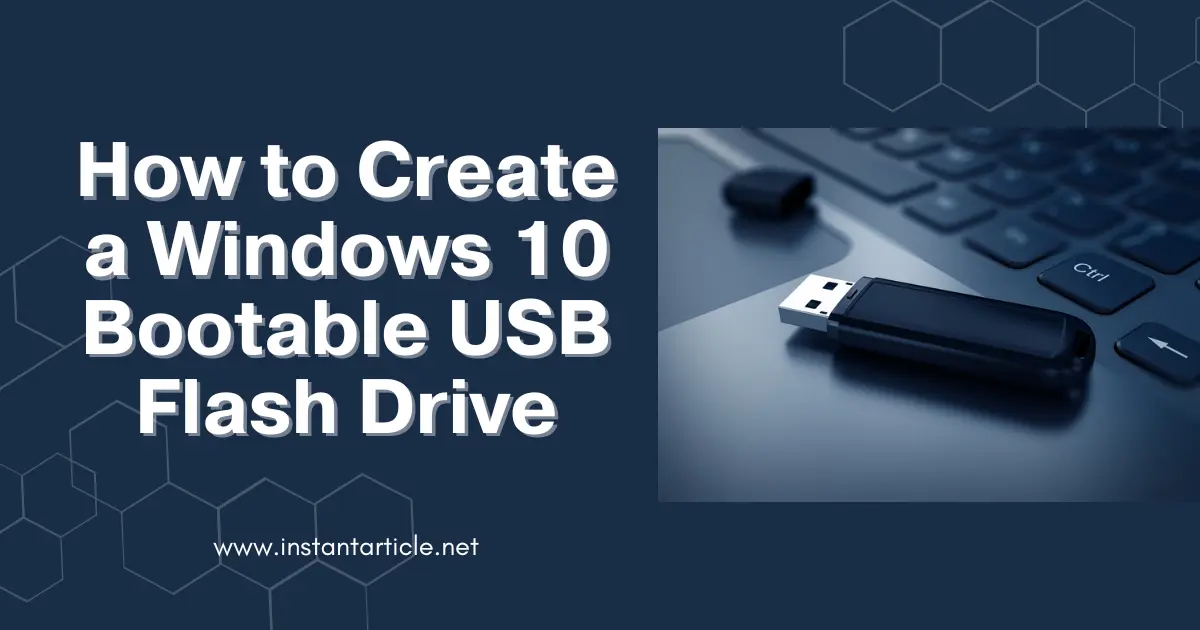Ever had your computer crash right before a big deadline? That sinking feeling is the worst—I’ve been there. But what if I told you that you could turn a simple USB drive into a powerful tool that could save your day? In this guide, I’ll show you exactly how to create a Windows 10 bootable USB flash drive, step by step, so you’ll never have to panic again.
Whether you’re a tech newbie or someone who’s been around computers for a while, this guide is designed to make the process easy and stress-free. I’ll walk you through everything you need to know, from downloading the necessary files to booting up your PC with your brand-new USB. With Windows 10 nearing its end of life, having a bootable USB ready for installations or repairs is more important than ever. And if you’re contemplating an upgrade, don’t miss our Comprehensive Guide on Whether You Should Install Windows 11. By the end of this guide, you’ll have a handy tool ready for any Windows 10 installation or upgrade you need. So, let’s dive in and get you equipped with this must-have skill!
Why You Should Create a Windows 10 Bootable USB
So why bother creating a bootable USB? Well, if you’ve ever been stuck with a computer that refuses to start, you’ll understand the importance. A bootable USB allows you to install or repair Windows 10 quickly and easily. It’s portable, reusable, and much more convenient than dealing with CDs or DVDs. I can’t count how many times mine has come in handy, not just for myself, but also for helping out friends and family who’ve run into tech trouble.
What You’ll Need (Don’t Worry, It’s Simple!)
Before we dive in, let’s make sure you’ve got everything you need:
- A USB Flash Drive: You’ll want at least 8 GB of storage. Heads up—this process will wipe everything on the drive, so make sure to back up anything important first.
- A Windows 10 ISO File: This is the file that contains all the Windows 10 installation goodies. If you don’t have it yet, don’t worry—I’ll guide you on how to get it.
- A Windows PC: You’ll need a computer running Windows to create the bootable USB.
- A Reliable Internet Connection: To download the tools and files we’ll be using.
Step 1: Download the Windows 10 ISO File
The first thing we need to do is grab the Windows 10 ISO file. Back when I did this for the first time, I wasn’t even sure what an ISO file was—I just knew I needed it! Thankfully, it’s pretty straightforward. Here’s how to get it:
- Head over to the Microsoft Windows 10 download page.
- Click on Download tool now to get the Windows 10 Media Creation Tool.
- Once you’ve got it, run the tool, and select Create installation media (USB flash drive, DVD, or ISO file) for another PC.
- Choose the language, edition, and architecture that matches your computer (most modern PCs are 64-bit).
- Select ISO file when prompted, and save it somewhere you’ll remember.
This might take a bit of time depending on your internet speed, so feel free to grab a snack while it downloads.
Step 2: Prepare the USB Flash Drive
Next up, we need to get the USB flash drive ready. This means formatting the drive to ensure it’s clean and ready for the Windows files. Trust me, you don’t want to skip this step—I’ve learned the hard way that it’s better to take the time to do it right!
- Plug your USB flash drive into your computer.
- Open File Explorer, right-click on the USB drive, and select Format.
- In the Format window, choose FAT32 as the file system. This is the most compatible option, especially if you’re using different types of systems.
- Click Start to begin formatting. Remember, this will erase everything on the drive, so double-check that you’ve backed up any important files.
Once the formatting is done, your drive is ready for action.
Step 3: Use the Media Creation Tool
Now for the main event—creating the bootable USB. I’ve got to say, the Media Creation Tool makes this process super easy. The first time I used it, I was relieved at how straightforward it was.
- Run the Windows 10 Media Creation Tool you downloaded earlier.
- Accept the license terms (because let’s be honest, who actually reads those?).
- Select Create installation media (USB flash drive, DVD, or ISO file) and click Next.
- Pick the language, Windows edition, and architecture that suits your needs, then click Next.
- Choose USB flash drive as your media, and hit Next.
- Select your USB flash drive from the list and click Next. The tool will now download the necessary files and set up your bootable USB.
Depending on your internet speed and USB drive, this process might take a bit of time. I usually just let it do its thing while I catch up on emails or watch some YouTube videos.
Step 4: Manually Create a Bootable USB (If You’re Feeling Brave)
If you’re like me and enjoy getting into the nitty-gritty, you might want to try creating the bootable USB manually using Command Prompt. It’s a bit more hands-on, but it’s a great way to learn more about how your computer works.
Alternatively, if you prefer using a third-party tool, you can create a bootable USB using Rufus. Rufus is a popular, free tool that makes the process quick and easy. Below is a video tutorial that guides you through the steps:
- Open Command Prompt as an administrator. Just search “cmd” in the Start menu, right-click, and select Run as administrator.
- Type
diskpartand press Enter to launch the DiskPart utility, which lets you manage disks and partitions. - Type
list diskand press Enter. You’ll see a list of all connected drives. Make sure you correctly identify your USB drive by its size. - Select your USB drive by typing
select disk X, replacing “X” with the correct disk number, and press Enter. - Type the following commands one by one, pressing Enter after each:
cleancreate partition primaryselect partition 1activeformat fs=fat32 quickassign
- Exit DiskPart by typing
exitand pressing Enter.
Now you’ll need to copy the Windows 10 installation files to the USB drive:
- Mount the Windows 10 ISO file by double-clicking on it. This will create a virtual drive.
- Copy all the files from the virtual drive to your USB flash drive. It might take a little time, but once it’s done, your USB drive will be ready to go.
Going the manual route might seem a bit tricky, but it’s incredibly satisfying to see it work. Plus, it’s a great skill to have under your belt for future projects.
Step 5: Boot from the USB Flash Drive
With your bootable USB in hand, it’s time to put it to use. I remember being nervous the first time I had to boot from a USB, but it’s actually pretty simple.
- Plug the bootable USB drive into the computer where you want to install Windows 10.
- Restart the computer and enter the BIOS or UEFI settings. You’ll usually do this by pressing a key like F2, F10, F12, or DEL during startup (it varies by computer, so you might need to look it up).
- In the BIOS/UEFI settings, find the boot order section and set the USB flash drive as the first boot device.
- Save your changes and exit the BIOS/UEFI. Your computer will restart and boot from the USB drive.
Once it starts up, you’ll see the Windows 10 installation screen. From there, just follow the on-screen instructions, and you’ll have a fresh installation of Windows 10 in no time.
Frequently Asked Questions (FAQs)
Absolutely! If you prefer, you can use Command Prompt (as I showed earlier) or a third-party tool like Rufus. Rufus is great because it’s fast and user-friendly. Just be sure to download it from the official site to avoid any unwanted surprises.
You should use the FAT32 file system. FAT32 is compatible with both BIOS and UEFI systems, making it the best choice for a bootable USB. If your ISO file is larger than 4 GB, which FAT32 doesn’t support, you can use NTFS. Just keep in mind that not all systems can boot from an NTFS drive, so FAT32 is generally safer.
You’ll need at least 8 GB of storage space. I usually go for a 16 GB drive, just to be safe. That extra space can come in handy if you want to add other tools to the drive.
Yes, you can use the bootable USB to install Windows 10 on multiple computers. Just remember, each installation will require its own valid Windows license. I’ve used the same USB to set up Windows on a few different machines for friends and family—it’s definitely a time-saver!
If your USB drive isn’t detected, try plugging it into a different USB port. Sometimes, using a USB 2.0 port instead of a USB 3.0 port can solve the issue, especially on older computers. Also, double-check that the drive is properly formatted and that the installation files are correctly copied.
Conclusion
Creating a Windows 10 bootable USB flash drive might sound technical, but once you’ve done it, you’ll wonder why you didn’t do it sooner. It’s a great tool to have, whether you’re setting up a new computer, fixing a problem, or just like being prepared for anything.
Keep your bootable USB somewhere safe—I’ve found it incredibly useful over the years. And hey, if you ever find yourself needing to help out a friend with a tech issue, you’ll be the hero with the magic USB drive.
If you run into any trouble or have questions, feel free to drop a comment below. I’ve been through this process more times than I can count, and I’m happy to help out!
Happy computing!

